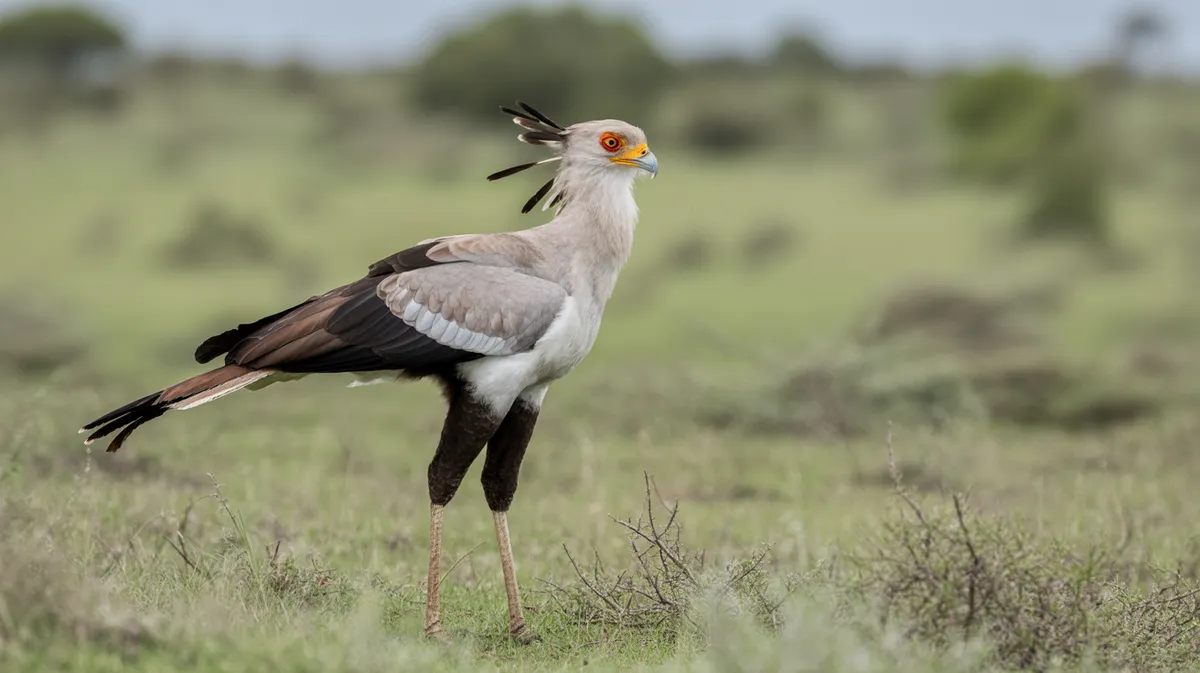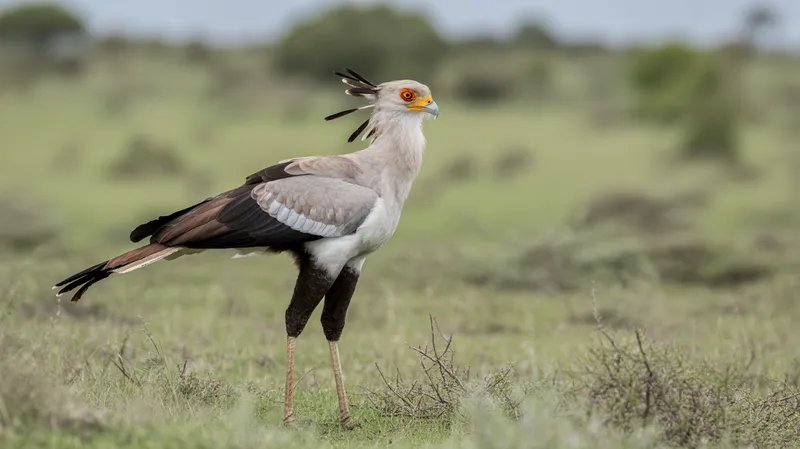
Secretary Bird
Sagittarius serpentarius

Meet the Secretary Bird
The Secretary Bird is a large, terrestrial bird of prey native to sub-Saharan Africa, easily recognized by its long legs, eagle-like body, and distinctive black-tipped feathers that resemble quill pens behind its head. Unlike most raptors, the Secretary Bird spends most of its time on the ground, striding across grasslands in search of prey. It is renowned for its unique hunting technique, using powerful kicks to stun and kill snakes and other small animals. The bird’s striking appearance and formidable predatory skills make it a captivating species within the African savanna ecosystem.
Classification
Bird
Habitat
Savanna and open grassland
Diet
Carnivore
Lifespan
10-15 years in the wild
Conservation
Vulnerable
Weight
2.3–4.5 kg
📖Fascinating Facts
Ground Hunter
Secretary Birds spend most of their time on foot, using their long legs to stride through grasslands in search of prey.
Snake Specialist
They are famous for their ability to hunt and kill venomous snakes with rapid, powerful kicks.
Unique Appearance
The black feathers at the back of their head resemble quill pens, which is how they got their name.
📋Detailed Description
The Secretary Bird (Sagittarius serpentarius) is a strikingly large terrestrial raptor, standing up to 1.3 meters (4.3 feet) tall with a wingspan reaching 2.1 meters (6.9 feet). Its most distinctive features include exceptionally long, crane-like legs, an eagle-like hooked bill, and a crest of elongated black feathers at the back of the head, reminiscent of quill pens—hence its common name. The plumage is predominantly pale grey with contrasting black flight feathers, thighs, and tail tips. Adapted for life on the ground, the Secretary Bird has robust, muscular legs with thick scales that provide protection against snake bites. It is an agile and powerful walker, capable of covering up to 30 kilometers (18 miles) a day while foraging. The species is diurnal and spends most daylight hours hunting in open savannas and grasslands. Socially, Secretary Birds are usually observed alone or in pairs, though small family groups may form during the breeding season. Their vocalizations are generally limited to guttural croaks and clucks, especially during displays or when alarmed. The Secretary Bird's unique combination of raptorial and terrestrial adaptations makes it an apex predator of its habitat, specializing in hunting snakes and other small vertebrates.
💡 Did you know?
Despite their impressive size and fierce hunting skills, Secretary Birds are capable of flight and can soar great distances, though they prefer to walk while hunting.
🔬Research & Sources
Wikipedia Summary
The secretarybird or secretary bird is a large bird of prey that is endemic to Africa. It is mostly terrestrial, spending most of its time on the ground, and is usually found in the open grasslands and savanna of the sub-Saharan region. John Frederick Miller described the species in 1779. A member of the order Accipitriformes, which also includes many other diurnal birds of prey such as eagles, hawks, kites, vultures, and harriers, it is placed in its own family, Sagittariidae.
Last Modified: 5/26/2025
🎭Behavior & Social Structure
Secretary Birds are primarily solitary or found in monogamous pairs, exhibiting strong territoriality over large home ranges. They are highly terrestrial, spending up to 90% of their active time walking rather than flying. Their hunting behavior is characterized by methodical striding through grasslands, using keen eyesight to detect prey from a distance. Upon spotting prey—often snakes, lizards, rodents, or insects—they rapidly approach and deliver powerful, precise downward kicks with their feet, capable of exerting forces up to five times their body weight. This stunning blow can kill or incapacitate even venomous snakes. Secretary Birds may also use their wings to distract or corral prey, and they occasionally stamp their feet to flush out hidden animals. Feeding is typically opportunistic, and they may scavenge carrion or raid bird nests for eggs and chicks. Roosting occurs in tall acacia trees or thorny shrubs, where they are safe from ground predators. Daily routines involve early morning and late afternoon foraging, with midday rest during the hottest hours.
👶Reproduction & Life Cycle
Secretary Birds are monogamous, forming long-term pair bonds that may persist for several years. Courtship involves aerial displays with soaring, undulating flights and mutual calling. Breeding season varies regionally but often coincides with the rainy season, when prey is abundant. Nests are large, flat platforms constructed from sticks and lined with grass, typically built 2–13 meters (6.5–43 feet) above ground in thorn trees or acacias. The female lays 1–3 eggs, which are incubated for 42–46 days, mainly by the female while the male provides food. Both parents participate in feeding the chicks, regurgitating partially digested food. Chicks fledge at around 60–80 days but may remain dependent on parents for several weeks post-fledging. Breeding success is closely linked to prey availability and habitat quality.
🛡️Adaptations & Survival
The Secretary Bird exhibits several unique adaptations for terrestrial predation. Its elongated legs not only allow for rapid ground movement but also keep its body elevated above tall grasses and out of reach of snake strikes. The legs are covered in tough, scale-like skin that offers protection from bites and thorns. Unlike most raptors, the Secretary Bird's toes are not strongly curved, reflecting its adaptation for walking and striking rather than grasping. Its sharp, hooked beak is well-suited for tearing flesh. The bird's exceptional eyesight enables it to detect prey at great distances. Behaviorally, its hunting technique—stomping and kicking—has evolved specifically for subduing dangerous prey like snakes, a rare specialization among birds of prey. The ability to fly remains important for roosting, display, and territory defense.
📚Research Sources
🎨Cultural Significance
The Secretary Bird holds a prominent place in African culture and symbolism. It is the national emblem of Sudan and features on the coat of arms of South Africa, symbolizing vigilance, authority, and protection. Its snake-hunting prowess has made it a subject of folklore, often regarded as a guardian against evil or misfortune. In some traditions, the bird is believed to bring good luck or serve as a totem animal. The distinctive 'quill pen' crest has inspired various myths about its name, with one theory suggesting resemblance to 19th-century clerks who carried quill pens behind their ears. The Secretary Bird is also a popular subject in wildlife art and ecotourism.
🔬Recent Research & Discoveries
Recent research has focused on the biomechanics of the Secretary Bird's hunting technique, revealing that its leg muscles and tendons are specially adapted to deliver rapid, forceful kicks capable of stunning or killing prey instantly. Studies using high-speed video and force sensors have quantified the speed and impact of these kicks, providing insights into convergent evolution with terrestrial predators. Ongoing ecological studies are examining the effects of habitat fragmentation and climate change on population dynamics. Genetic analyses have confirmed the Secretary Bird's unique evolutionary lineage, supporting its placement in a monotypic family (Sagittariidae). Conservation research is increasingly using satellite telemetry to track movements and habitat use, informing management strategies.
🎥Wildlife Videos

THE SECRETARY BIRD : Nature’s Most Powerful Hunter in Action! | Animal Documentary
THE SECRETARY BIRD : Nature’s Most Powerful Hunter in Action! | Animal Documentary THE SECRETARY BIRD : Nature’s Most Powerful ...
The Majestic - Animal Documentary

THE SECRETARY BIRD: Nature’s Most Powerful Hunter in Action! | Animals Documentary | BBTV Official
In the ruthless world of the African savanna, where every step could mean life or death, one bird reigns supreme — feared even ...
BBTV Official

The Secretary Bird: Africa’s Deadly Stalker | Bird documentary | Wild Wings
The Secretary Bird: Africa's Deadly Stalker | Bird documentary | Wild Wings Dive into the breathtaking world of wild animals with ...
Wild Wings

Even snakes FEAR this Bird | The Kung Fu Secretary Bird
With a name like theirs, you'd think secretary birds are some kinda sweet, indoor pet, but you'd be terribly wrong. These lanky ...
Wildacious

The Eagle That Kills Its Prey By Stomping On It | Our World
This groundbreaking documentary reveals the identity of the secretary bird and discovers why it stamps on poisonous snakes.
Our World

THE SECRETARY BIRD Nature’s Most Powerful Hunter in Action!
THE SECRETARY BIRD Nature's Most Powerful Hunter in Action! Meet the Secretary Bird – the long-legged, snake-crushing ...
Wild Wings
🌍Habitat Information
The Secretary Bird typically inhabits Savanna and open grassland environments. Secretary Birds have adapted to their environments with specialized features and behaviors.
Primary Habitat:
Savanna and open grassland
More detailed habitat information will be available soon.
🛡️Conservation Status
The Secretary Bird is currently classified as Vulnerable. Conservation efforts are crucial for preserving this species for future generations.
Common Threats:
- 🏠Habitat loss and fragmentation
- 🌡️Climate change impacts
- 🎯Hunting and poaching
- 🏭Human-wildlife conflict
⚠️Threats & Conservation Challenges
The Secretary Bird is currently classified as Vulnerable by the IUCN, with populations estimated to be declining across much of its range. Major threats include habitat loss and fragmentation due to agricultural expansion, overgrazing, and urban development, which reduce suitable foraging and nesting sites. Human disturbance, direct persecution (e.g., hunting or trapping), and collisions with power lines also pose risks. In some areas, the use of pesticides and rodenticides may reduce prey availability or cause secondary poisoning. Fire regimes that alter grassland structure can further impact breeding success. While the species is still widespread, population declines are most pronounced in West and East Africa, with some local extinctions reported. Conservation efforts focus on habitat protection, awareness campaigns, and monitoring population trends.
🔬Scientific Classification
Scientific Name
Sagittarius serpentarius
Classification Hierarchy
🔍 About Taxonomic Classification
Taxonomic classification is a hierarchical system used by scientists to classify and organize living organisms based on shared characteristics and evolutionary relationships.
The system moves from broad categories (Kingdom) to increasingly specific ones, with each animal's scientific name typically consisting of its Genus and species.
📝Community Notes
Share your observations and insights about the Secretary Bird with our community of wildlife enthusiasts.
Join Our Community
Sign in to share your observations and connect with fellow wildlife enthusiasts.
Sign In to ContributeNo community notes yet
Be the first to share your observations about the Secretary Bird!
Explore Secretary Bird
Select a tab above to learn more about this amazing animal.
📸Photo Gallery
No photos available for this animal yet.
🌟Discover More Wildlife
Continue your journey of discovery with more fascinating animals from our database
